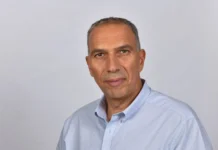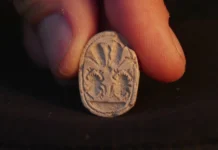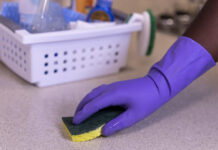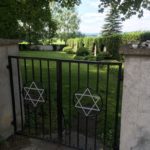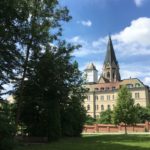ohn Glass bowed his head as the cantor’s melody echoed through the cemetery in prayer for the children buried beneath the grassy-green surface.
Church bells sounded in the distance, a reminder of the unlikely setting for a Jewish mourning ritual, along with the monks in black hooded robes among the minyan. The leader of the prayer recited el mal’eh rachamim, a Hebrew blessing usually reserved for graveside burials or memorial services, including Holocaust remembrances. But in this instance, those honored that day – 16 children in all – perished in the weeks, months and years after Allied forces liberated Nazi Germany. Some of them, including Glass’ brother, died so young they never received names.
These Jewish refugees called themselves Sh’erit ha-Pletah, the surviving remnant. Many of them had no desire to return to the European countries where the Nazi regime had robbed them of their homes and families. Yet they faced an uncertain future in the face of strict immigration policies in the United States and Great Britain, including British-occupied Palestine. For many of these displaced people, according to their children, their years at St. Ottilien were the happiest of their lives, even if they rarely spoke of the interlude after they left.
From April 1945 to May 1948, some 5,000 people passed through St. Ottilien’s Displaced People (DP) camp. Though the camp was overseen by the U.S. Army and later the United Nations Relief and Rehabilitation Administration, Jewish survivors assumed key roles as teachers, physicians and members of a police force tasked with keeping the uneasy peace among the Jews, Germans and monks occupying the space.
The camp included a school and one of the first hospitals in the American zone run by Jewish doctors and nurses. It also housed the region’s central maternity wing for Jewish patients, where more than 400 children were born in those three years.
Glass was among the last of the refugees born at the monastery in March 1948, number 423 of the “Ottilien babies.” (His brother had died the previous year of respiratory failure.) For Glass, visiting St. Ottilien was a homecoming to the place where his family started anew, and as far as he and others knew, it was the first kaddish performed in the cemetery since the burials. It was a milestone in his family’s legacy and in the history of St. Ottilien, he says.
“It’s mixed emotions, being here,” the 70-year-old lecturer says. “It’s hard, knowing what my parents went through. But being here is like being with them.”
The impromptu ceremony took place during a three-day academic symposium centered on St. Ottilien and the broader context of the DP moment. Held last month, the joint effort of the University of Munich, the Jewish Museum of Munich and St. Ottilien brought new attention to a topic that was, until recently, a largely overlooked period in Holocaust studies and the history of Germany and Israel.
The new body of research comes as the personal memory of the Nazi genocide fades with the deaths of the last remaining survivors. Most symposium attendees were like Glass; they had a personal connection to the monastery, and the meeting was a chance for them to return to their roots and learn more about them.
Now in their 60s and 70s, many of the St. Ottilien babies said they want to share their parents’ legacy with the next generation. Amid the global refugee crisis and the rise of extremist groups, they don’t want their parents’ experience to be forgotten or repeated.
Some attendees, including Glass, had visited St. Ottilien before. Others made the trip for the first time, including Alec Savicki, whose sister, Leah, died of a cerebral hemorrhage at St. Ottilien around the same time Glass’ brother.

The two Australian Jews stood side-by-side in the cemetery to recite the kaddish for their deceased siblings. Their mothers had met at Dachau and spent time together in St. Ottilien, where Savicki’s father was a member of the camp’s police. Both families stayed in touch after immigrating to Australia, where — like many survivors — they had relatives who sponsored them. Compared to other countries, Australia had welcoming migration policies, enacted in part to ameliorate its own labor shortage .Savicki was born and raised in Melbourne, but he says he didn’t learn about his deceased sibling until he was in his 40s. His parents never spoke about their wartime experiences or the two years in which they lived St. Ottilien.
“I think that there’s a general process of life just to close yourself off from pain,” says Savicki, a doctor and patient advocate in Caulfield, a predominantly Jewish neighborhood about 10 minutes from downtown Melbourne. “What I could not understand is why my parents looked so happy in the photos that I have of them from that time. It didn’t make sense to me, because they’d just come out of the camps and I was thinking they should be wasted. How is it that they have smiles on their faces?”
*******
St. Ottilien Archabbey rises out of undulating green, Bavarian farmland on a winding road from the village of Eresing. Landscaped paths connect tidy modern facilities — a gift shop, a religious printing press —with ecclesiastical structures, including the St. Ottilia chapel for which this Benedictine congregation is named.
The order of St. Augustine began evangelizing to Germanic tribes in the seventh century, constructing abbeys with schools for monks and outside scholars that were among western Europe’s chief centers of learning, literature and education. Otherwise, the Benedictine rule focused on creating autonomous communities of peace and prayer, each with its own role within the larger community. In 1884, a former monk left an archabbey in Germany’s upper Danube valley to start an independent congregation that combined the Benedictine way of life with missionary work. Three years later, the community moved and became the Ottilien congregation. That same year, the fledgling community embarked on its first mission in East Africa.
The archabbey added amenities in the first years of the 20th century, including a guesthouse, a printing press and facilities to support agricultural operations. It also opened an infirmary with an X-ray machine and other state-of-the art equipment, resources that caught the attention of the Nazi regime.
On April 17, 1941, the Gestapo gave the monks two hours to leave the buildings with few personal belongings, says Father Cyril Schaefer, the head of St. Ottilien’s publishing house. Of about 220 monks, the younger ones were conscripted into the German army, the elders were kicked out, and 63 monks stayed at the monastery to perform forced labor on the farm and on the upkeep of a new military hospital.
The first wave of Jewish DPs to reach St. Ottilien were survivors of the deaths marches in Bavaria, says Atina Grossman, a history professor at Cooper Union in New York and author of Jews, Germans and Allies: Close Encounters in Occupied Germany. Some came from the various Kaufering camps and others in the vicinity, she says, and others were on their way to Dachau when the American advance intercepted the marches.
Grossman and other scholars at the conference said that the historic record is not clear on how the first wave of Holocaust survivors found St. Ottilien or how the hospital fell into the hands of Jewish physicians after. Two of those scholars cited as one plausible explanation the account of the first chief doctor of St. Ottilien’s hospital, a 33-year-old physician from Lithuania named Zalman Grinberg, my grandfather.
One group of refugees had come from a train likely bound for Dachau’s crematorium in the final days of the war. But Allied forces had bombed the train on April 27, mistaking it for a Nazi munitions transport, mistakenly killing 150 people near the village of Schwabhausen. The survivors buried the dead in three mass graves along the train tracks, and a stone bearing the star of David was laid atop each site one year later. The gravestones remain there today, accompanied by a sign that explains their significance in English and German.
The sign includes a quote from Grinberg commanding his comrades to bury the dead in their first act of self-determination since the war had begun. Grinberg had survived the Kovno ghetto and the forced labor camps around Dachau partly because his captors allowed him to act as a physician. This duty spared him some of the hard labor and indiscriminate brutality that befell other captives and allowed him to join an underground resistance that secretly assumed leadership roles within the camps, roles that continued after liberation. In his 1946 memoir, Liberation from Dachau, my grandfather describes learning about the military hospital at St. Ottilien from a physician in Schwabhausen, where he had also convinced the local council chief to give the refugees shelter in makeship camps that had housed Hitler’s troops.
According to the memoir, he next impersonated a member of the International Red Cross during a phone call with the chief physician of the military hospital and ordered him to accept the refugees. The next day, Americans arriving in Schwabhausen oversaw the transport of the refugees to the hospital and made Grinberg medical director.
In speeches and letters, Grinberg expressed his vision for a haven where displaced Jews could rehabilitate physically and spiritually and rebuild the Jewish community. But in the first few months my grandfather was frustrated by what he viewed as the international community’s willful neglect of survivors through lack of aid and mismanagement of the camps. Nearly one month later, in a speech during a “liberation concert” at St. Ottilien,, he characterized their plight as such:
“We are free now, but we do not know how, or with what to begin our free yet unfortunate lives. It seems to us that for the present mankind does understand what we have through and experienced during this period. And it seems to us that we shall neither be understood in the future.”
Because the hospital was beyond capacity, filled with some 1,000 German soldiers, the Jewish survivors took up space in a gymnasium. More refugees of varied wartime trajectories flooded the monastery as Allied forces emptied out camps, Grossman says. Some were survivors of Nazi camps and the ghettos in the East. Others were on death marches from camps that were shut down as the Red Army approached; some had survived in hiding. Others had been liberated from camps and first tried to go “home” to Poland and other parts of eastern Europe only to find those homes a vast graveyard, and fled to the American zone, she said.
Camp and ghetto survivors, however, constituted the minority of Jewish DP survivors, Grossman said at the conference.The vast majority, including those who passed through St. Ottilien, were refugees originally from eastern Europe who fled the Nazi occupation into the Soviet Union.
While research continues of the varied paths survivors took to DP camps, Grossman calls the role of the Soviet Union as the site where most Jewish DPs survived the war another overlooked aspect of the Holocaust narrative, one that challenges the overarching, undifferentiated stories of victims and survivors.
St. Ottilien was one of about two dozen of DP camps to arise in the American zone from 1945 to 1946. Most of them were in former military installations, forced-labor camps and even concentration camps. Refugees in many DP camps lived in unsanitary conditions, behind barbed wire, with their movements restricted by armed guards. Food, medical supplies and basic needs such as bedding were scarce. Some survivors still wore the black and white striped uniforms of the camps or discarded SS regalia of those who terrorized them. In a report to President Harry Truman, Earl G. Harrison, the American representative on the International Committee of Refugees, suggested that the only difference between Nazi and American-run camps was that the latter were not operating gas chambers.
Survivors arrived at the camps with a host of overlapping health issues— tuberculosis, starvation, infectious skin conditions — that were exacerbated by deficient care, said Jael Geis of the Jewish Museum in Berlin at the conference. At St. Ottilien, some died within days of reaching the monastery; the first funeral was held on April 30, less than a week after the first arrivals showed up, said University of Munich graduate student Julia Schneidawind. Through 1948, more than 60 Jews were buried in a cemetery on the monastery’s perimeter, next to one for the monks who served at the abbey.
St. Ottilien, while still not home, offered a hospitable setting in comparison to other DP camps. The monastery saw the return of Jewish life through prayer services, the observance of holidays and the printing of the first Talmud using the monastery’s printing press. Word of its maternity ward spread among Jewish refugees. Ottilien baby David Avnir, who also attended the conference, recalls that his mother, Michaela, left her home in Munich for St. Ottilien in June 1947 just so she could give birth there to him. After a three-week stay, she returned to Munich, where her husband, Israel Steingarten, had accepted a job as the editor and publisher of a Yiddish-language newsletter, one of many to arise in the postwar era to promote the Zionist cause and immigration to Israel. The family made their way to Israel, where David’s sister Maya was born. Their parents seldom spoke of Munich, St. Ottilien or the years prior.
Avnir, a noted scientist and chemistry professor at Hebrew University, surmises that his parents wanted to protect their children from the ugly parts of their lives. His mother only opened up about her experiences when her children were adults. He has pictures of his mother cradling him at St. Ottilien in which she appears to be happier than any other time in her life that he can remember.
“After years of being a refugee, hungry and cold, and not knowing where she would get her next shower, suddenly everyone was taking care of her,” he said.
Among the topics discussed at the symposium was the role of the monks themselves in the rehabilitation process. According to the scholars present, the brothers were frustrated with their own inability to conduct their lives under the Nazi regime due to their suppression. As the war came to a close, they, too, wanted to return home, says University of Munich history professor Dr. Evita Wiecki, who helped organize the symposium. Cooperating with the Americans brought them closer to their goal.
Gates of the Cemtry Courtesy of Emanuella Grinberg)
Gates of the Cemetery (Courtesy of Emanuella Grinberg)
Courtesy of Emanuella Grinberg
Attitudes have changed since then, even if the monks’ hospitality did feel long overdue. Lingering resentment and misgivings could only be healed with time, Father Cyril said in his opening remarks, delivered in English.
“Today, we are very proud of this hospital,” he said. “We are happy that for some years it became a home for people who desperately needed peace and healing.”
“And thinking of the many miracles performed in only a few years, we have to say the suppression of the monastery and its transformation into a hospital was perhaps the most important event in its existence.”
For years, letters had come to the monastery seeking information. “My father Yankle Goldberg was one of the Ottilien babies,” began one letter written in 2018 by Gali Ron, a makeup artist in Israel. She attended the symposium with her father, baby number 240, who now goes by his Hebrew name, Yaakov Harpaz. His cousin Chaja Goldberg, number 295, was also there, along with a friend and former coworker of his.
Excerpts from Ron’s letters and baby pictures of her relatives are featured in a new exhibit at the monastery gift shop. and Father Cyril credits those pieces of correspondence and others with paving the way to the symposium by opening his eyes to this overlooked chapter, one that he and other monks felt deserved greater attention.
He met his first Ottilien family in the late 1990s, when the children of survivor Chaim Ipp visited the abbey. Ipp was part of St. Ottilien’s first team of Jewish physicians, and he became chief doctor after my grandfather moved to Palestine in 1946. His wife gave birth to their first son, Moshe, on their way to St. Ottilien in 1945, and their second son, Eli, was born there in 1946.
Both are now doctors themselves and attended the symposium with their wives and three of Eli’s adult children. They had visited before, Moshe Ipp pointed. “This time, our family has expanded.”

